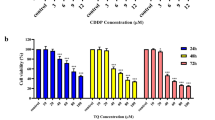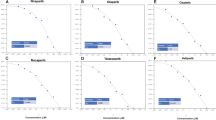Abstract
This study was designed to determine the ideal manner (schedule and duration) of intravesical chemotherapy using pirarubicin (THP). At first, T-24 cancer cells were treated with 50, 100, 150, and 200 μg/ml THP for 10, 30 and 60 min. Following the first exposure, at various intervals (3, 6, 12, and 24 h), a second exposure to THP was performed under the same condition in vitro. The cell viability was measured by XTT assay. Further, the cells were scanned with a laser scanning cytometer (LSC) and DNA histograms were analyzed to evaluate the cell-cycle components. A single exposure of T-24 cells to THP resulted in significantly higher inhibition of cell growth for 30 min with 100 μg/ml and higher concentrations of THP; for example, the cell viability was reduced to 15, 2, and 0% by incubating cells with 100, 150, and 200 μg/ml of THP, respectively, whereas it was 49% with 50 μg/ml THP. Double exposure of T-24 cells to THP resulted in significantly higher inhibition of cell growth than single treatment at all intervals. LSC assay demonstrated a higher sub-G1 peak after double treatment with THP when compared with that after a single treatment. Similar cytotoxic effects following double treatment with THP were observed on other bladder cancer cell lines (UMUC3, TCCSUP, 5637, and 253J cells) in vitro. In conclusion, the double short-term exposure to bladder cancer cells by THP has more remarkable cytotoxic effects than the single exposure in vitro.




Similar content being viewed by others
Abbreviations
- THP:
-
Tetrahydropyranyl adriamycin (pirarubicin)
- LSC:
-
Laser scanning cytometer
- TURBT:
-
Transurethral resection of bladder tumor
References
Oosterlinck W, Lobel B, Jakse G, Malmström PU, Stöckle M, Strenberg C. Guidelines on bladder cancer. Eur Urol. 2002;41:105–12.
Miki T, Nonomura N, Kojima Y, Okuyama A, Nakano E, Kiyohara H, et al. A randomized study on intravesical THP (THP) chemoprophylaxis of recurrence after transurethral resection of superficial bladder cancer. Hinyokika Kiyo. 1997;43:907–12.
Lutzeyer W, Rubben H, Dahm H. Prognostic parameters in superficial bladder cancer: an analysis of 315 cases. J Urol. 1982;127:250–2.
Lamm DL, Torti FM. Bladder cancer, 1996. CA Cancer J Clin. 1996;46:93–112.
Soloway MS, Sofer M, Vaidya A. Contemporary management of stage T1 transitional cell carcinoma of the bladder. J Urol. 2002;167:1573–83.
Sylvester RJ, van der MA, Lamm DL. Intravesical bacillus Calmette-Guerin reduces the risk of progression in patients with superficial bladder cancer: a meta-analysis of the published results of randomized clinical trials. J Urol. 2002;168:1964–70.
Lee C, Park MS. Prophylactic treatment of superficial bladder tumor. Int J Urol. 1998;5:511–20.
Nilsson S, Ragnhammar P, Glimelius B, Nygren P. A systematic overview of chemotherapy effects in urothelial bladder cancer. Acta Oncol. 2001;40:371–90.
Brausi M, Collette L, Kurth K, van der Meijden AP, Oosterlinck W, Witjes JA, et al. Variability in the recurrence rate at first follow-up cystoscopy after TUR in stage Ta T1 transitional cell carcinoma of the bladder: a combined analysis of seven EORTC studies. Eur Urol. 2002;41:523–31.
Hinotsu S, Akaza H, Ohashi Y, Kotake T. Intravesical chemotherapy for maximum prophylaxis of new early phase superficial bladder carcinoma treated by transurethral resection: a combined analysis of trials by the Japanese Urological Cancer Research Group using smoothed hazard function. Cancer. 1999;86:1818–26.
Matsumura Y. Cooperative study of therapy of superficial bladder cancer by intravesical instillation of pirarubicin. Am J Clin Oncol. 1990;13(suppl 1):S5–10.
Yamamoto Y, Nasu Y, Saika T, Akaeda T, Tsushima T, Kumon H. The absorption of pirarubicin instilled intravesically immediately after transurethral resection of superficial bladder cancer. BJU Int. 2000;86:802–4.
Fukushima T, Ueda T, Nakamura T. Pharmacokinetics and action mechanism of anthracyclines. Gan To Kagaku Ryoho. 1992;19:445–50.
Akaza H, Niijima T, Hisamatsu T, Fujigaki M, et al. Comparative investigation on use of (2″R)-4′-O-tetrahydropyranyl-adriamycin and adriamycin as intravesical chemotherapy for superficial bladder tumors. Urology. 1988;32:141–5.
Sylvester RJ, Oosterlinck W, Witjes JA. The schedule and duration of intravesical chemotherapy in patients with non-muscle-invasive bladder cancer: a systematic review of the published results of randomized clinical trials. Eur Urol. 2008;53:709–19.
Maier S, Reich E, Martin R, Bachem M, Altug V, Hautmann RE, et al. Tributyrin induces differentiation, growth arrest and apoptosis in androgen-sensitive and androgen-resistant human prostate cancer cell lines. Int J Cancer. 2000;88:245–51.
Heney NM, Ahmed S, Flanagan MJ, Frable W, Corder MP, Hafermann MD, et al. Superficial bladder cancer: progression and recurrence. J Urol. 1983;130:1083–6.
Pode D, Alon Y, Horowitz AT, Vlodavsky I, Biran S. The mechanism of human bladder tumor implantation in an in vitro model. J Urol. 1986;136:482–6.
Fitzpatrick JM, West AB, Butler MR, Lane V, O’Flynn JD, et al. Superficial bladder tumors (stage pTa, grades 1 and 2): the importance of recurrence pattern following initial resection. J Urol. 1986;135:920–2.
Soloway MS, Masters S. Urothelial susceptibility to tumor cell implantation: influence of cauterization. Cancer. 1980;46:1158–63.
Sugano O, Hatakeyama T, Kato H. Investigation of retention time of intravesical instillation therapy with pirarubicin (THP). Gan To Kagaku Ryoho. 1996;23:1169–74.
Takamoto S, Ota K. Flow cytometric analysis of the effect of THP-adriamycin on the cell cycle traverse of RPMI-8402 cells: comparison with adriamycin. Gan To Kagaku Ryoho. 1986;13:1868–75.
Tanaka M, Yoshida S, Kimura K. Mechanism of inhibition of DNA polymerases by 4′-epiadriamycin and 4′-O-tetrahydropyranyladriamycin. Gann. 1983;74:829–36.
Acknowledgments
We thank Ms. Chihiro Sato and Ms. Akiko Kawara-Yamazaki for technical assistance.
Author information
Authors and Affiliations
Corresponding author
About this article
Cite this article
Maruyama, T., Higuchi, Y., Suzuki, T. et al. Double short-time exposure to pirarubicin produces higher cytotoxicity against T24 bladder cancer cells. J Infect Chemother 17, 11–16 (2011). https://doi.org/10.1007/s10156-010-0088-y
Received:
Accepted:
Published:
Issue Date:
DOI: https://doi.org/10.1007/s10156-010-0088-y




